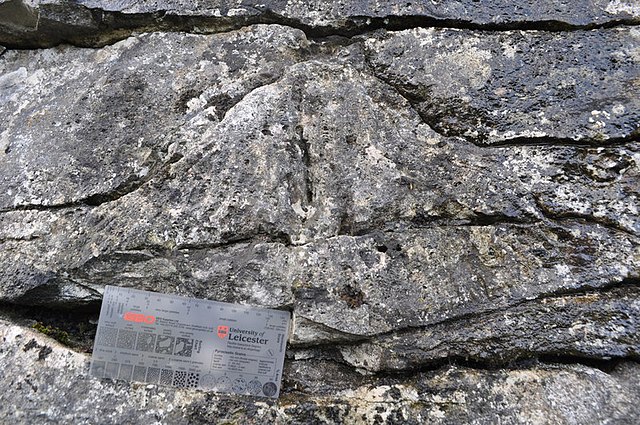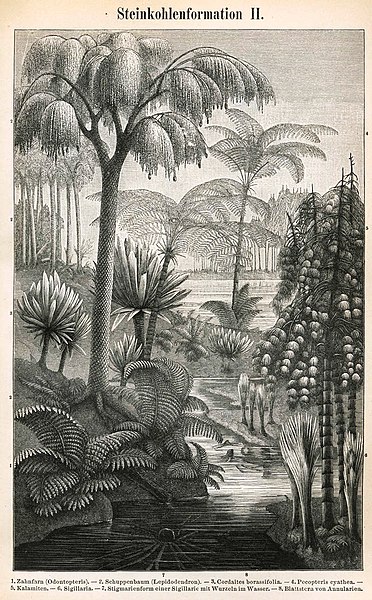Carboniferous Limestone is a collective term for the succession of limestones occurring widely throughout Great Britain and Ireland that were deposited during the Dinantian Epoch of the Carboniferous Period. These rocks formed between 363 and 325 million years ago. Within England and Wales, the entire limestone succession, which includes subordinate mudstones and some thin sandstones, is known as the Carboniferous Limestone Supergroup.
Carboniferous Limestone exposed at Ogmore-by-Sea, Wales. Carboniferous/Jurassic unconformity.
Carboniferous Limestone exposed at Tedbury Camp, Somerset, England.
Cross-section of Carboniferous Limestone bored by Jurassic organisms; borings include Gastrochaenolites (some with boring bivalves in place) and Trypanites; Mendip Hills, England; scale bar = 1 cm.
Carboniferous coral, Ingleton, North Yorkshire
The Carboniferous is a geologic period and system of the Paleozoic that spans 60 million years from the end of the Devonian Period 358.9 Ma to the beginning of the Permian Period, 298.9 Ma. In North America, the Carboniferous is often treated as two separate geological periods, the earlier Mississippian and the later Pennsylvanian.
Cliff section through the Serpukhovian Red Wharf Limestone Formation, Wales. A marine limestone at the base of the cliff is overlain by an orange-coloured fluvial sandstone. Subaerial exposure of the limestone during a period of falling sea level resulted in the formation of a karstic surface, which has then been infilled by the river sands. A thin, estuarine silty mudstone overlays the sandstone, which in turn is overlain by a second marine limestone.
Hyden Formation over Pikeville Formation in the Pennsylvanian of Kentucky, US. The exposure has Pennsylvanian-aged cyclothemic sedimentary rocks of the Breathitt Group. The upper part of the roadcut is Hyden Formation, consisting of mixed siliciclastics and coal. The lower part is Pikeville Formation, also having mixed siliciclastics and coal.
A reconstruction of life on a forest floor during the Pennsylvanian Period. The reptile is Edaphosaurus, a pelycosaur. Plants are the seed ferns Neuropteris and Pectopteris, the club mosses Lepidodendron and Sigillaria, other plants include Cordaites, Calamites, climbing ferns, pond algae, and Sphenophyllum.
Etching depicting some of the most significant plants of the Carboniferous








